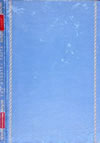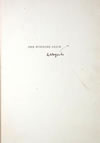
BL. W. B. Yeats
 |
 |
30. The Winding Stair. New York: Fountain, 1929. Enlarged ed., London: Macmillan, 1933.
The 1933 edition reprints Byzantium and Symbols (32a-b) and the Crazy Jane Poems (33).
a. A Dialogue of Self and Soul. The dialogue is between a Soul that calls the poet to an ‘ancestral night’ of escape from the wheel of life and death, and a Self, which even in old age and sickness affirms the blessedness of life, and calls upon as its symbol ‘Sato’s ancient blade . . . / Still razor sharp, still like a looking-glass / Unspotted by the centuries’, and ‘the old embroidery, torn / From some court-lady’s dress’, which bound around the scabbard ‘Can, tattered, still protect, faded adorn’ (ll. 9-16; see especially 21 and 48k). When the voice of the Soul protests that a man ‘past his prime’ should not ‘remember things that are / Emblematical of love and war’ but instead seek deliverance from ‘the crime of death and birth’, the voice of the Self returns to the sword and to its history, and makes its symbolism explicit: ‘Montashigi, third of his family, fashioned it / Five hundred years ago, about it lie / Flowers from I know not what embroidery— / Heart’s purple—and all these I set / For emblems of the day against the tower / Emblematical of the night, / And claim as by a soldier’s right / A charter to commit the crime once more’ (pp. 25-32). Yeats wrote to Olivia Shakespear of the poem that he makes the sword and its silk covering the ‘symbol of [his] life’ (48p). ‘Montashigi’, as often has been noted, is a corruption of Motoshige, the family name of the sword maker, who according to Sato (see 124, p. 133) flourished 1394-1428. The connection to Japanese subjects in the poem perhaps does not end with Sato’s sword. Writing about Yeats’s interest in Zen has often been ill-informed, but in the first published work to speculate about a Zen influence in his mature poetry (see 66), his friend George Russell (Æ) is careful not to overstate the case, and finds that the ‘acceptance of life’ in this work may have come from Yeats’s ‘study’ of Zen. See also 73, 139, 220, and 224.

